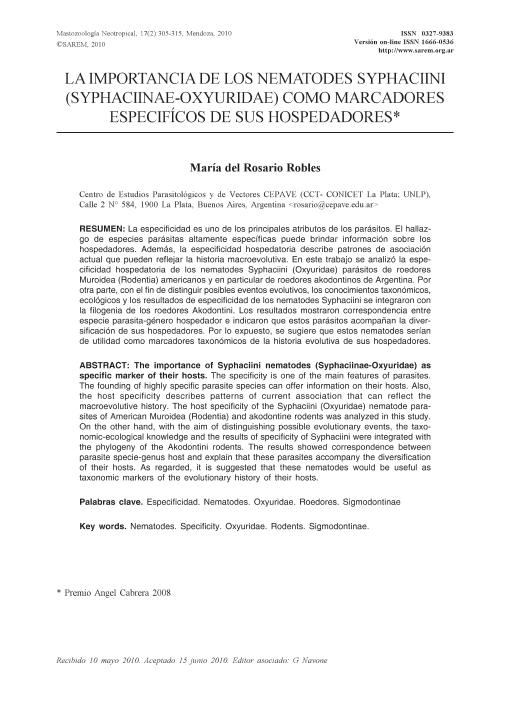Mostrar el registro sencillo del ítem
dc.contributor.author
Robles, Maria del Rosario

dc.date.available
2020-06-04T17:36:14Z
dc.date.issued
2010-12
dc.identifier.citation
Robles, Maria del Rosario; La importancia de los nematodes syphaciini (syphaciinae-oxyuridae) como marcadores específicos de sus hospedadores; Unidad de Zoología y Ecología Animal, Instituto Argentino de Investigación de Las Zonas Aridas, Cricyt, Conicet; Mastozoología Neotropical; 17; 2; 12-2010; 305-315
dc.identifier.issn
0327-9383
dc.identifier.uri
http://hdl.handle.net/11336/106699
dc.description.abstract
La especificidad es uno de los principales atributos de los parásitos. El hallazgo de especies parásitas altamente específicas puede brindar información sobre los hospedadores. Además, la especificidad hospedatoria describe patrones de asociación actual que pueden reflejar la historia macroevolutiva. En este trabajo se analizó la especificidad hospedatoria de los nematodes Syphaciini (Oxyuridae) parásitos de roedores Muroidea (Rodentia) americanos y en particular de roedores akodontinos de Argentina. Por otra parte, con el fin de distinguir posibles eventos evolutivos, los conocimientos taxonómicos, ecológicos y los resultados de especificidad de los nematodes Syphaciini se integraron con la filogenia de los roedores Akodontini. Los resultados mostraron correspondencia entre especie parasita-género hospedador e indicaron que estos parásitos acompañan la diversificación de sus hospedadores. Por lo expuesto, se sugiere que estos nematodes serían de utilidad como marcadores taxonómicos de la historia evolutiva de sus hospedadores.
dc.description.abstract
The specificity is one of the main features of parasites. The founding of highly specific parasite species can offer information on their hosts. Also, the host specificity describes patterns of current association that can reflect the macroevolutive history. The host specificity of the Syphaciini (Oxyuridae) nematode parasites of American Muroidea (Rodentia) and akodontine rodents was analyzed in this study. On the other hand, with the aim of distinguishing possible evolutionary events, the taxonomic-ecological knowledge and the results of specificity of Syphaciini were integrated with the phylogeny of the Akodontini rodents. The results showed correspondence between parasite specie-genus host and explain that these parasites accompany the diversification of their hosts. As regarded, it is suggested that these nematodes would be useful as taxonomic markers of the evolutionary history of their hosts.
dc.format
application/pdf
dc.language.iso
spa
dc.publisher
Unidad de Zoología y Ecología Animal, Instituto Argentino de Investigación de Las Zonas Aridas, Cricyt, Conicet

dc.rights
info:eu-repo/semantics/openAccess
dc.rights.uri
https://creativecommons.org/licenses/by-nc/2.5/ar/
dc.subject
SYPHACIA
dc.subject
SIGMODONTINAE
dc.subject
TAXONOMIA
dc.subject
ESPECIFICIDAD
dc.subject.classification
Ciencias de las Plantas, Botánica

dc.subject.classification
Ciencias Biológicas

dc.subject.classification
CIENCIAS NATURALES Y EXACTAS

dc.title
La importancia de los nematodes syphaciini (syphaciinae-oxyuridae) como marcadores específicos de sus hospedadores
dc.title
The importance of syphaciini nematodes (syphaciinae-oxyuridae) as specific marker of their hosts
dc.type
info:eu-repo/semantics/article
dc.type
info:ar-repo/semantics/artículo
dc.type
info:eu-repo/semantics/publishedVersion
dc.date.updated
2020-05-11T15:18:55Z
dc.identifier.eissn
1666-0536
dc.journal.volume
17
dc.journal.number
2
dc.journal.pagination
305-315
dc.journal.pais
Argentina

dc.journal.ciudad
Argentina
dc.description.fil
Fil: Robles, Maria del Rosario. Consejo Nacional de Investigaciones Científicas y Técnicas. Centro Científico Tecnológico Conicet - La Plata. Centro de Estudios Parasitológicos y de Vectores. Universidad Nacional de La Plata. Facultad de Ciencias Naturales y Museo. Centro de Estudios Parasitológicos y de Vectores; Argentina
dc.journal.title
Mastozoología Neotropical

dc.relation.alternativeid
info:eu-repo/semantics/altIdentifier/url/http://ref.scielo.org/cct2qk
Archivos asociados
